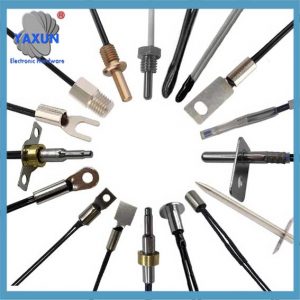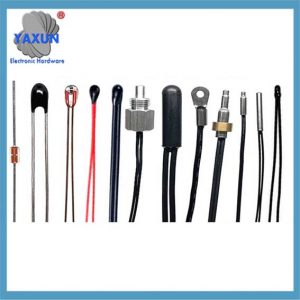수천 가지 NTC 서미스터 유형을 접할 때, 올바른 것을 선택하는 것은 상당히 부담스러울 수 있습니다. 이 기술 문서에서는, 서미스터를 선택할 때 염두에 두어야 할 몇 가지 중요한 매개변수를 안내해 드리겠습니다.. 이는 온도 감지에 사용되는 두 가지 일반적인 유형의 서미스터 중에서 선택할 때 특히 그렇습니다.: 음의 온도 계수 NTC 서미스터 또는 실리콘 기반 선형 서미스터. NTC 서머 스터는 저렴한 가격으로 인해 널리 사용됩니다., 그러나 극한 온도에서 정확도가 낮습니다. 실리콘 기반 선형 서미스터는 더 넓은 온도 범위에서 더 나은 성능과 정확도를 제공합니다., 그러나 일반적으로 더 비쌉니다. 아래에서 볼 수 있듯이, 보다 비용 효율적인 것을 제공하는 다른 선형 서미스터가 시장에 출시됩니다., 고성능 옵션. 솔루션의 전반적인 비용을 증가시키지 않고 광범위한 온도 감지 요구를 해결하는 데 도움이됩니다..
응용 프로그램에 대한 올바른 서미스터는 많은 매개 변수에 따라 다릅니다., ~와 같은:
· 자료 청구서 (Bom) 비용;
· 저항 내성;
· 교정 지점;
· 감도 (섭씨 학위 당 저항의 변화);
· 자조 및 센서 드리프트;
BOM 비용
서미스터 자체는 비싸지 않습니다. 그들은 개별적이기 때문에, 추가 회로를 사용하여 전압 강하를 변경할 수 있습니다.. 예를 들어, 비선형 NTC 서머 스터를 사용하는 경우 장치를 통해 선형 전압 강하를 원하는 경우, 이 특성을 달성하기 위해 추가 저항을 추가하도록 선택할 수 있습니다.. 하지만, BOM 및 총 솔루션 비용을 줄일 수있는 또 다른 대안은 원하는 전압 강하를 자체적으로 제공하는 선형 서미스터를 사용하는 것입니다.. 좋은 소식은 새로운 선형 서미스터 패밀리와 함께, 둘 다 가능합니다. 이는 엔지니어가 설계를 단순화 할 수 있음을 의미합니다, 시스템 비용을 줄입니다, 인쇄 회로 보드를 줄입니다 (PCB) 적어도 레이아웃 크기 33%.
저항 공차
서미스터는 25 ° C에서 저항 내성으로 분류됩니다, 그러나 이것은 온도에서 어떻게 변화하는지 완전히 설명하지 않습니다.. 최소값을 사용할 수 있습니다, 전형적인, 및 장치 저항 대에서 제공되는 최대 저항 값. 온도 (R-T) 특정 온도 범위에 대한 공차를 계산하기위한 설계 도구 또는 데이터 시트의 테이블.
서미스터 기술로 공차가 어떻게 변하는 지 설명합니다, NTC와 TMP61 실리콘 기반 서미스터를 비교해 봅시다. 둘 다 ± 1% 저항 내성에 대한 평가입니다. 수치 1 온도가 25 ° C에서 멀어지면서 두 장치의 저항 내성이 증가 함을 보여줍니다., 그러나 극한 온도에서 둘 사이에는 큰 차이가 있습니다.. 이 차이를 계산하여 관심있는 온도 범위에 비해 더 낮은 공차를 유지하는 장치를 선택할 수 있습니다..
온도 센서에 적합한 서미스터를 선택하는 방법
수치 1: 저항 공차: NTC 대. TMP61
교정 지점
저항 공차 범위 내에서 서미스터가 어디에 있는지 알지 못하면 더 넓은 오류 마진이 필요하기 때문에 시스템 성능이 저하됩니다.. 교정은 어떤 저항 값을 기대할 것인지 알려줍니다, 오류 마진을 크게 줄이는 데 도움이 될 수 있습니다.. 하지만, 제조 공정의 추가 단계입니다, 따라서 교정은 최소한으로 유지되어야합니다.
교정 지점의 수는 사용 된 서미스터 유형과 응용 프로그램의 온도 범위에 따라 다릅니다.. 좁은 온도 범위, 하나의 교정 지점은 대부분의 서머 스터에 적합합니다. 넓은 온도 범위가 필요한 응용 분야, 두 가지 옵션이 있습니다: 1) NTC로 세 번 교정하십시오 (이것은 극한 온도에서의 감도가 낮고 저항 내성이 높기 때문입니다.). 또는 2) 실리콘 기반 선형 서미스터로 한 번 교정하십시오, NTC보다 더 안정적입니다.
감광도
섭씨 학위 당 저항의 큰 변화 (감광도) 서미스터에서 좋은 정확도를 얻으려고 할 때 도전 중 하나입니다.. 하지만, 소프트웨어에서 저항 값을 얻지 않는 한, 보정을 통해 또는 저항 내성이 낮은 서머 스터를 선택함으로써, 큰 감도는 도움이되지 않습니다.
NTC는 저항 값이 기하 급수적으로 감소하기 때문에 저온에서 감도가 매우 높습니다., 그러나 온도가 증가함에 따라 그들은 또한 극적으로 떨어집니다.. 실리콘 기반 선형 서미스터는 NTC와 동일한 높은 감도를 갖지 않습니다., 따라서 전체 온도 범위에서 안정적인 측정을 제공합니다.. 온도가 증가함에 따라, 실리콘 기반 선형 서미스터의 감도는 일반적으로 약 60 ° C에서 NTC의 감도를 초과합니다..
자조 및 센서 드리프트
서머 스터는 에너지를 열로 소산합니다, 이는 측정 정확도에 영향을 줄 수 있습니다. 소산 된 열의 양은 많은 매개 변수에 따라 다릅니다, 재료 구성 및 장치를 통해 흐르는 전류 포함.
센서 드리프트는 시간이 지남에 따라 서미스터가 표류하는 양입니다., 일반적으로 저항 값의 백분율 변화로 주어진 가속 수명 시험을 통해 데이터 시트에 지정됩니다.. 응용 프로그램에 일관된 감도와 정확성으로 긴 수명이 필요한 경우, 자조가 적고 작은 센서 드리프트가있는 서머 스터를 선택하십시오..
따라서 NTC를 통해 TMP61과 같은 실리콘 선형 서미스터를 언제 사용해야합니까??
테이블을보고 있습니다 1, 같은 가격으로 볼 수 있습니다, 실리콘 선형 서미스터의 지정된 작동 온도 범위 내에서 거의 모든 상황에서 실리콘 선형 서미스터의 선형성 및 안정성으로부터 이익을 얻을 수 있습니다.. 실리콘 선형 서미스터는 상업용 및 자동차 버전 및 표준으로도 제공됩니다. 0402 그리고 0603 표면 마운트 장치 NTC에 공통적 인 패키지.
테이블 1: NTC 대. Ti 실리콘 선형 서미스터
TI 서머 스터 용 Ret R-T 테이블 및 예제 코드가있는 쉬운 온도 변환 방법의 경우, 서머 스터 설계 도구를 다운로드하십시오.
 English
English Afrikaans
Afrikaans العربية
العربية বাংলা
বাংলা bosanski jezik
bosanski jezik Български
Български Català
Català 粤语
粤语 中文(简体)
中文(简体) 中文(漢字)
中文(漢字) Hrvatski
Hrvatski Čeština
Čeština Nederlands
Nederlands Eesti keel
Eesti keel Suomi
Suomi Français
Français Deutsch
Deutsch Ελληνικά
Ελληνικά हिन्दी; हिंदी
हिन्दी; हिंदी Magyar
Magyar Bahasa Indonesia
Bahasa Indonesia Italiano
Italiano 日本語
日本語 한국어
한국어 Latviešu valoda
Latviešu valoda Lietuvių kalba
Lietuvių kalba македонски јазик
македонски јазик Bahasa Melayu
Bahasa Melayu Norsk
Norsk پارسی
پارسی Polski
Polski Português
Português Română
Română Русский
Русский Cрпски језик
Cрпски језик Slovenčina
Slovenčina Slovenščina
Slovenščina Español
Español Svenska
Svenska ภาษาไทย
ภาษาไทย Türkçe
Türkçe Українська
Українська اردو
اردو Tiếng Việt
Tiếng Việt



